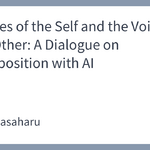When I sit down to write and face myself, I do not play music (BGM). I don’t even wear earphones; I often just place myself in the silence of the room.
I particularly avoid “music with lyrics,” because I have a personal feeling that the act of weaving words interferes with another linguistic system—the “meaning” of the lyrics—and confuses my channels of thought.
However, this choice to write in a “quiet, BGM-free environment” is not merely a passive act of eliminating noise. Rather, I believe it is a very active and essential process for listening to the “music” of the text that is yet to be written.
To speak a bit grandiloquently, the silence that fills the room during writing is not merely an “absence of sound.” That silence, I would say, is a special space for discerning the “melody and rhythm” of the text to be born, and the “premonitions and flashes of insight” that have not yet become words.
There is a work by John Cage titled “4’33”.” It is a sensational piece in which the performer does not play any instrument for four minutes and thirty-three seconds.
What this work suggested was not the “absence of sound” itself, but the “existence of inner sound”—the ambient sounds of the surroundings that the audience hears during that time, or their own heartbeats and breathing—and the “active nature of listening.”
In this way, Cage made us reconsider “listening” through silence.
I believe that the “silent environment” in my writing process has a similar function.
The act of writing is not only about creating (or finding) words to address someone, but also about the practice of listening closely to the voice that rises from within oneself.
Fragments of thought, the rustle of memories, the flicker of emotions. From among these “noises” that do not yet have a logical structure, I pick up the “melody” that should become the core of the text. This process is very much like that of a composer playing with and searching for fragments of a yet-unseen music.
I previously wrote in “Contemplating Composition: A Hypothetical Model for Understanding the Creative Act” that a flash of inspiration in creation is “like a seed of creativity.” It could be described as a vague impulse to give form to something that has not yet become concrete notes, or a sense of conviction that “it must be this way.”
Similarly, in the context of writing, this “seed” is a fragment of a more fundamental “meaning” before it is expressed in words, and it can be the starting point for all writing.
In a sense, the silence during writing may be an excellent recording studio for perceiving this “inner music” and the “contour” and “resonance” of the prose that is about to be woven.
The reason I avoid music (BGM) when writing is to prevent this “language as inner music” from interfering with the “music heard from the outside,” and in the case of music with lyrics, to prevent the “meaning and structure of the lyrics” from interfering with each other.
Normally, for me, these should be processed through different channels of consciousness. However, the “musical world invading from the outside” (and its “linguistic world” of lyrics) that is BGM causes these channels to get crossed.
In such a situation, silence acts as a kind of “reset” function to restore the pure resonance of “language.” It is a time of quiet preparation and tuning before setting out into the sea of words.
Silence is by no means empty. In creation, it is a special space for diving deep into one’s inner self, for listening to the “music” that has not yet become sound, and for receiving the premonition (the seed of creativity) of the “text” that has not yet become words.
Thus, to stand in silence when beginning to write—it is the quiet before a new text is born, and at the same time, it is the time for listening to the most important first note of the “music” that is the writing to come.
If we suppose that a “music of creation” is always resounding in our hearts, then the act of writing is an attempt to visualize that inner music in the form of words. And I believe that this attempt can only demonstrate its true value with the stage setting of silence.


